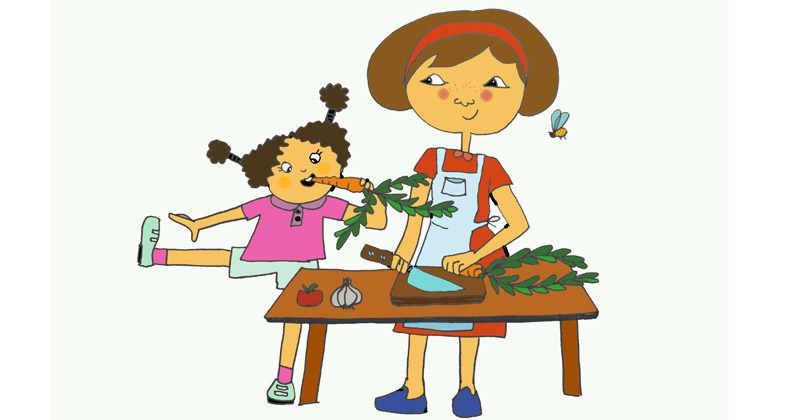My Toddler Loves Brussels Sprouts
Five Tips to Help Your Children Try New Foods
As parents we know how tough it can be to get our children to try new foods. No matter how hard we try, beg, or work to convince them that those Brussels sprouts are good for them, they just won’t taste them. Not even one bite. And so those sad sprouts end up being left on the plate or thrown onto the floor, and we wonder if our children will ever want to eat anything that is green and doesn’t taste like pasta.
Parents’ Facebook groups are full of concerns like that and related stories about super picky eaters who will only eat a very small selection of foods like pasta, milk, bread, cookies, or fruit; children who consume tiny meals or just show a general lack of interest in food.
Often, picky eating can be associated with non-behavioural challenges that need to be tackled first if we want to improve our children’s eating – for example, underlying food intolerances, nutrient deficiencies, low stomach acid, gut imbalance or (for a very small number of children) Sensory Processing Disorder.
However, behavioural strategies that help children develop healthy eating habits are important too and incorporating them into our daily lives can make a big difference in helping children grow up into healthy eaters. The earlier we start, the more effective these will be and the greater their impact on children’s comfort with different types of food, the palate range and their ability to make healthy food choices.
When it comes to encouraging them to try new foods in particular, here are five simple strategies that can be used with children at different stages of their development:
Take it step-by-step
To expand children’s palates, we need to include new foods in their menus regularly. However, when doing so, it is important not to overwhelm them with too many unfamiliar foods at once but rather to introduce things one at the time, together with a dish that they already know and like.
For example, if your little one loves mashed potatoes but has not had French beans before, serve these two together and avoid adding any other new foods. It is also important to start with small quantities of unfamiliar foods, rather than load the plate with them the first time, as this might discourage them from trying it.
Explore different textures and spin-off proven favourites
Your daughter might detest boiled carrots, but she will happily eat them roasted, raw and grated or mixed into a stew. Trying the same type of food in different forms will not only increase the chances of your child eating that food but will also help expand her palate due to different textures and flavours generated by different food preparation methods.
You can also introduce children to the different varieties of foods that they already like. If your son likes hazelnuts, introduce him also to Brazil nuts, cashew nuts, walnuts, etc. If he loves couscous, try the more nutritious quinoa, millet or amaranth. This will expand his palate as well as the range of nutrients he is getting from food, while keeping some of the core elements of the food he loves unchanged.
Give children (some) control
Involving children in choosing what will be included in their meals is important, to increase their sense of participation and control over their food choices, which ultimately also raises the likelihood of them eating the chosen food. This, of course, doesn’t mean letting them pick the entire family meal every day (otherwise most of us would be eating pasta and ice-cream all the time!), but rather presenting them with healthy options that they can choose from. For example:
- During grocery shopping, ask children to choose one new vegetable that they haven’t had before and that you can then cook together for one of your meals at home. You can do the same with grains, fruit, fish, meat, or nuts and pulses.
- If your children are a bit older, choose the main ingredient of the meal together (e.g. fish, meat, grains), and let them pick one or two specific recipes that you can then use to prepare the meal – ideally together. This will also help involve children in cooking, which is essential for developing healthy eating habits.
Make up silly names for different foods
This is effective particularly for toddlers. When we first introduced green juice in our house, my two-year old wouldn’t have it. But as soon as we started calling it “dinosaur juice,” he was drinking it like there was no tomorrow.
Giving nutritious foods that children are not that keen on fun names can help your child go from loathing a particular food to wanting to eat it every day. “X-ray vision carrots,” “power peas”; “tiny tasty tree tops” for broccoli, “dragon food” for French beans, and “teddy bear porridge” for oats are just some of the popular names that our clients use; but you can come up with your own, depending on what you think might engage your kids most.
Be patient and avoid pushiness
As parents, we would all love if our little ones would eat and enjoy all the food the first time we serve it. But, the research shows that it can take children up to 15 times to accept new food.
So, if your children don’t touch that salmon the first time you make it, do not despair.
Allow them to leave it on their plates if they don’t want to try it, and serve it again in a few days’ time, followed by another try a few days later, and so on.
During this process it is ok to ask the child if they want to touch, smell or eat this food, but it is very important not to push them, as this can have the opposite effect. Instead, relax, allow them to take their time getting familiar with the new food and lead by example by sharing a meal with them and eating the same food they are eating.
And finally, remember that children learn by imitation and that enthusiasm is contagious. You are their role model and if your children see you visibly enjoying the food that you want them to eat without pushing them to do so, they are more likely to try it, too.
By Klara Debeljak
Klara is the founder of Nourishi Consulting, a nutrition consultancy that specialises in family and children’s nutrition. To learn more about their work, find out about upcoming nutrition courses or book a personal nutrition consultation, visit www.nourishiconsulting.com or contact them directly at getintouch@nourishiconsulting.com. You can also stay up to date on their nutrition tips, articles about healthy eating and simple, healthy recipes by joining their Facebook community “Nourishi – Family & Children nutrition”.
Illustration by Susana Gutierrez
Susana is a project manager and freelance illustrator. She lives in Zurich and is mother of two girls. She can be reached at:
s.escapa@gmail.com




